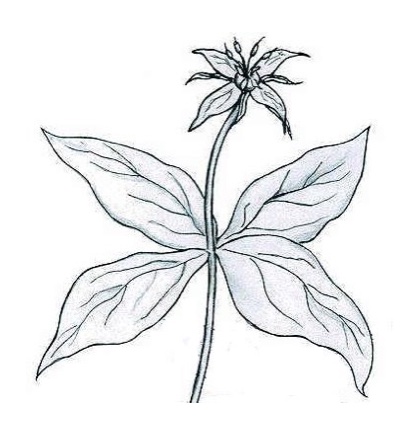
Rare Plants in Selsdon Wood
A number of rare or very uncommon plants have been found in Selsdon Wood and most recur each year.
Herb Paris - the FSW logo
Herb Paris (Paris quadrifolia) has been classified as an important biodiversity species by the The London Biodiversity Audit. It was once present in Bromley but since 2000 it has been found only in Selsdon Wood. Its presence is an indicator of ancient woodland
Its use as a logo predated the FSW as the ranger Ernie Thomason started using it on posters for his "Before the Buds Burst" tree walk in 2002 after learning that this rare species was in Selsdon Wood. The logo was adopted by FSW on our formation in 2007.
Although it was recorded in the Penry-Jones booklet in 1978, it is believed that the first Herb Paris to be spotted here in recent times was found in the Jubilee by Ted Frith. However the first photographed sighting was in 2012 by David Malins who found the plants beside the Bridle Way.
In 2016 we were contacted by Brian Pitkin (of Surrey Rare Plants) who reported that he had found more Herb Paris just north of the large Yew trees in Court Wood (see Committee Minutes 23/5/16).
Although typically the plant has 4 leaves (as in the logo) it may have any number from 3 to 8.
Plants continue to appear in the two known locations each year in April/May. The bottom picture (27/4/22) shows just a small part of the field of Herb Paris in the location in Court Wood





Toothwort
This first photograph of Toothwort (Lathraea squamaria) was taken by David Malins on 25/4/10 after Ernie Thomason showed us the plant in East Gorse on his guided walk. This plant was not recorded in the 1978 Penry-Jones booklet.
It has been sighted each year since 2010 in April/May.
This is a curious plant appearing without leaves that is parasitic on the roots of Hazel and a few other trees.
in 2022 a large clump of at least 7 flowers was spotted in the bole of a Field Maple close to the original location. The photograph (27/4/22) shows them a little past their best.

White Helleborine by Ted Forsyth 6/6/13
Helleborines
These are relatives of the orchid family and both White Helleborines (Cephalanthera damasonium) and Broad-leaved Helleborines (Epipactis helleborine) were found beside the Centenary Plantation in 2012-2014.
Sadly neither has been found there since but a White Helleborine was spotted in the woodland between Field 2 and Field 3 on 6/6/21.
The white Helleborine has flowering time of May - July and the Broad-leaved Helleborine July-September.
Broad-leaved Helleborine by Heather Govier 4/8/12
Early Purple Orchid
This first photograph of Early Purple Orchid (Orchis mascula) was taken by Heather Govier on 5/5/12 although it was recorded in the Penry-Jones booklet in 1978.
The photo shows the typical spotted leaves which distinguish the plant from nearby Bluebells before the flowers develop.
Four groups of Early Purple are known in Selsdon Wood - off Courtwood Grove, Beech Grove, Langford's Way and up the drug trail.
Flowers are seen annually in these locations in April/May.
In 2016 Ted Forsyth did a count of Early Purple Orchids. In the Beech Grove group there were at least 76 in flower, including several on the edge of the path between Broad Walk and Vale Border. At Courtwood Grove there were 23 to the right of the entrance path and 24 well-scattered to the left of the path.
Pyramidal Orchid
Anacamptis pyramidalis, the Pyramidal Orchid, is the most common orchid in Selsdon Wood and even appears by Bardolph Ave. It has been seen in all of the fields.
It was first photographed in 2012 and has appeared every year since although there were fewer in 2021.
Typically it is pink but we have also had the much rarer white version - about 7 plants were spotted in 2017 in Field 2. It has not been seen since.
On one occasion, in 2020, we also spotted one pale pink variant.



Bee Orchid
Bee Orchid (Ophrys apifera) is seen rarely in Selsdon Wood. The photograph was taken on 8/6/14 in Field 2 eastern border. It was also sighted in 2015 but has not been seen since.
Featherbed Lane verge however, has a well established colony which sometimes has 70 specimens.
Common Spotted Orchid
Despite the name, this orchid (Dactylorhiza fuchsii) is not very common in the wood with a few having been seen in Great Field and one in Field 2 near the Jubilee plantation.
However, dotted specimens have been spotted in Great Field in June each year since 2014.


Yellow Bird's Nest
Yellow Bird's Nest (Monotropa hypopitys) was first found on 16/1/19 by Michael Waller. At that time only the woody stem remained form the previous year's bloom. It was situated in Broad Walk close to the Bridle Way entrance and fresh blooms have been seen in later years in the same location - the one in the bottom photograph having been taken on 5/7/20.
This very curious saprophytic plant entirely lacks chlorophyll and appears to be feeding on the roots of a solitary Beech amongst Sweet Chestnut trees.
It has declined quite significantly in south-east England and new sites are rare. Moreover, there is only one other site for it in Greater London at High Elms Country Park in Bromley. A historic sighting in Court Wood is noted in the 1900 BSBI database.